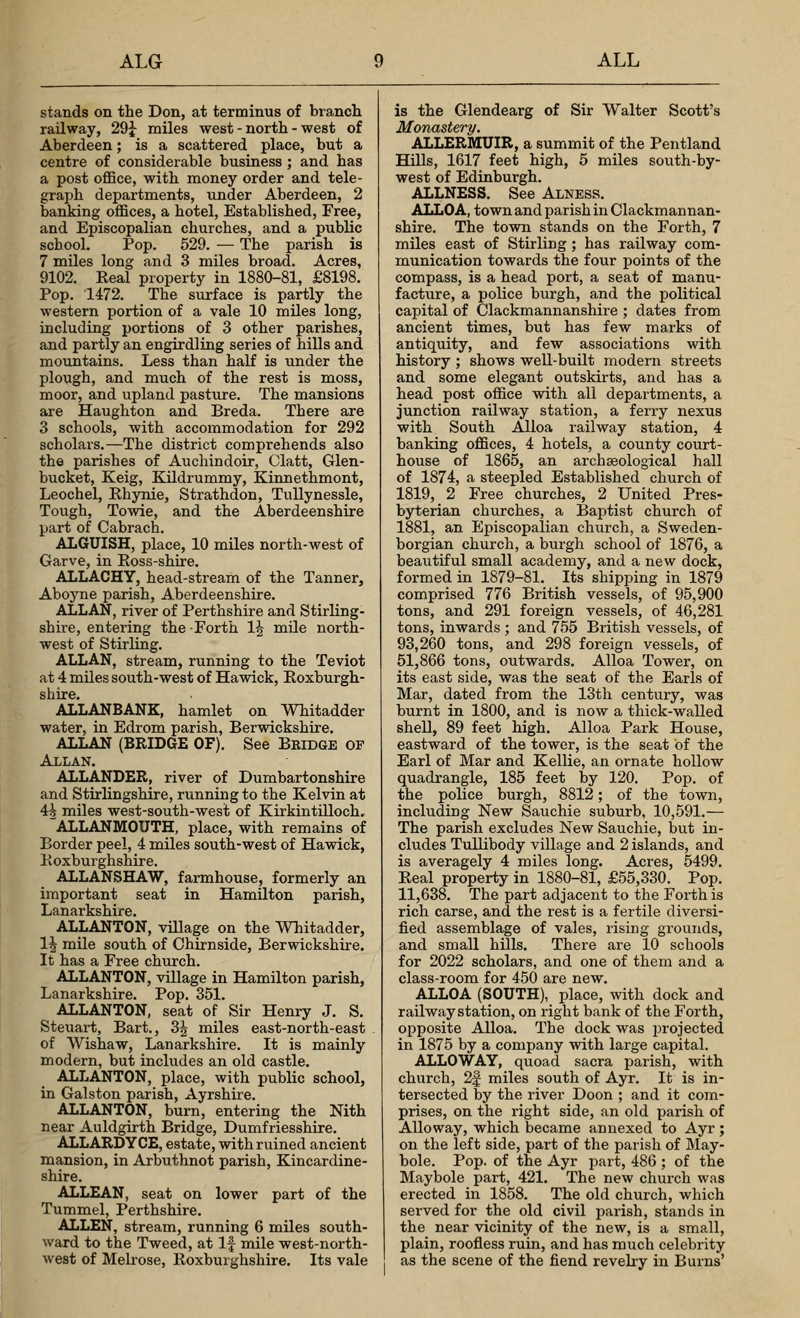ALGUISH, place, 10 miles north-west of Garve, in Ross-shire.
ALLACHY, head-stream of the Tanner, Aboyne parish, Aberdeenshire.
ALLAN, river of Perthshire and Stirlingshire, entering the Forth 1J mile north-west of Stirling.
ALLAN, stream, running to the Teviot at 4 miles south-west of Ha wick, Roxburghshire.
ALLANBANK, hamlet on Whitadder water, in Edrom parish, Berwickshire.
ALLAN (BRIDGE OF).
ALLANDER, river of Dumbartonshire and Stirlingshire, running to the Kelvin at 4i miles west-south-west of Kirkintillochr
ALLANMOUTH, place, with remains of Border peel, 4 miles south-west of Hawick, R oxburghshire.
ALLANSHAW, farmhouse, formerly an important seat in Hamilton parish, Lanarkshire.
ALLANTON, village on the Whitadder, 1J mile south of Chirnside, Berwickshire. It has a Free church.
ALLANTON, village in Hamilton parish, Lanarkshire. Pop. 351.
ALLANTON, seat of Sir Henry J. S. Steuart, Bart., 3^ miles east-north-east of Wishaw, Lanarkshire. It is mainly modern, but includes an old castle.
ALLANTON, place, with public school, in Galston parish, Ayrshire.
ALLANTON, burn, entering the Nith near Auldgirth Bridge, Dumfriesshire.
ALLARDYGE, estate, with ruined ancient mansion, in Arbuthnot parish, Kincardineshire.
ALLEAN, seat on lower part of the Tummel, Perthshire.
ALLEN, stream, running 6 miles south-ward to the Tweed, at If mile west-north-west of Melrose, Roxburghshire. Its vale is the Glendearg of Sir "Walter Scott's Monastery.
ALLERMUIR, a summit of the Pentland Hills, 1617 feet high, 5 miles south-by-west of Edinburgh.
ALLNESS.
ALLOA, town and parish in Clackmannanshire. The town stands on the Forth, 7 miles east of Stirling ; has railway communication towards the four points of the compass, is a head port, a seat of manufacture, a police burgh, and the political capital of Clackmannanshire ; dates from ancient times, but has few marks of antiquity, and few associations with history ; shows well-built modern streets and some elegant outskirts, and has a head post office with all departments, a junction railway station, a ferry nexus with South Alloa railway station, 4 banking offices, 4 hotels, a county court-house of 1865, an archaeological hall of 1874, a steepled Established church of 1819, 2 Free churches, 2 United Presbyterian churches, a Baptist church of 1881, an Episcopalian church, a Sweden-borgian church, a burgh school of 1876, a beautiful small academy, and a new dock, formed in 1879-81. Its shipping in 1879 comprised 776 British vessels, of 95,900 tons, and 291 foreign vessels, of 46,281 tons, inwards ; and 755 British vessels, of 93,260 tons, and 298 foreign vessels, of 51,866 tons, outwards. Alloa Tower, on its east side, was the seat of the Earls of Mar, dated from the 13th century, was burnt in 1800, and is now a thick-walled shell, 89 feet high. Alloa Park House, eastward of the tower, is the seat of the Earl of Mar and Kellie, an ornate hollow quadrangle, 185 feet by 120. Pop. of the police burgh, 8812; of the town, including New Sauchie suburb, 10,591. The parish excludes New Sauchie, but includes Tullibody village and 2 islands, and is averagely 4 miles long. Acres, 5499. Real property in 1880-81, 55,330. Pop. 11,638. The part adjacent to the Forth is rich carse, and the rest is a fertile diversified assemblage of vales, rising grounds, and small hills. There are 10 schools for 2022 scholars, and one of them and a class-room for 450 are new.
ALLOA (SOUTH), place, with dock and railway station, on right bank of the Forth, opposite Alloa. The dock was projected in 1875 by a company with large capital.
ALLOWAY, quoad sacra parish, with church, 2f miles south of Ayr. It is intersected by the, river Doon ; and it com-prises, on the right side, an old parish of Alloway, which became annexed to Ayr ; on the left side, part of the parish of Maybole. Pop. of the Ayr part, 486 ; of the Maybole part, 421. The new church was erected in 1858. The old church, which served for the old civil parish, stands in the near vicinity of the new, is a small, plain, roofless ruin, and has much celebrity as the scene of the fiend revelry in Burns' Tarn o' Shanter. The ' Auld Brig o' Doon, ' figuring also in Tarn o' Shanter, a new bridge erected since Burns' time, a cyclo-style monument to Burns, erected in 1820, and a neat inn, called Burns', are in the same vicinity ; and Burns' cottage, where the poet was born, is about f mile to the north, and was purchased in September 1880 for 4000, to be converted into a Burns' museum.

